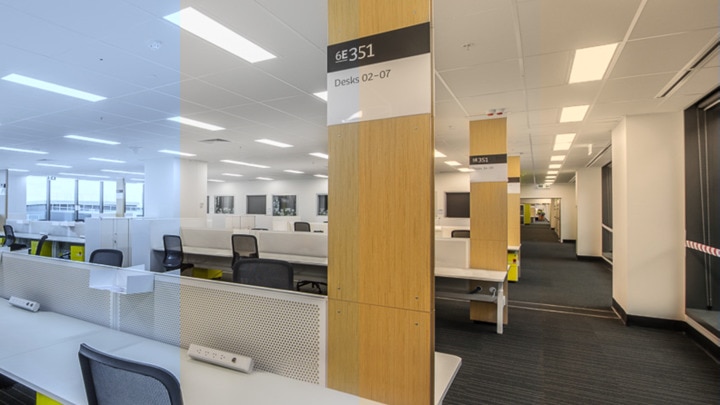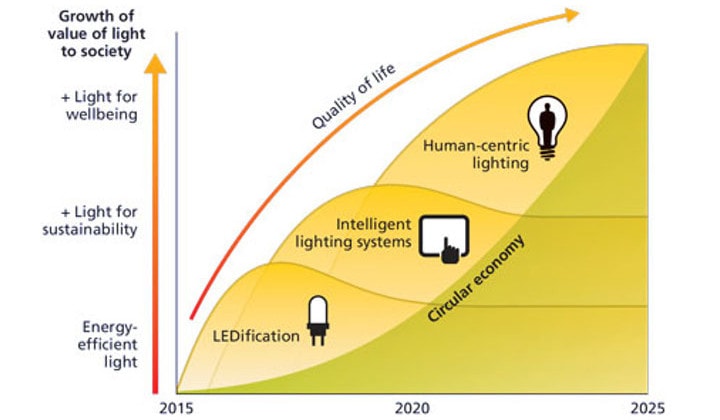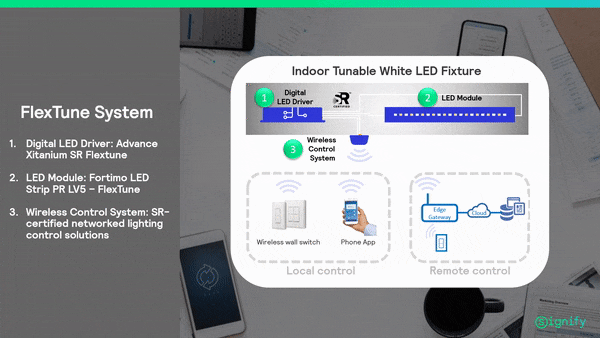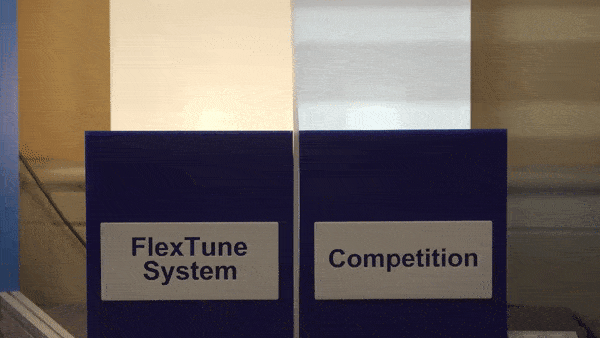
In 1973 Motorola unveiled the world’s first handheld mobile phone and made the first publicized mobile phone call1. Nineteen years later, the first true smartphone, Simon Personal Communicator by IBM, made its debut2. In 2007, the iconic iPhone was introduced with its touchscreen interface. This innovation helped transform the mobile communications industry and lead to smartphones becoming an indispensable part of our everyday lives. Steve Jobs said it best during the first unveiling of iPhone: “We are all born with the ultimate pointing device—our fingers—and iPhone uses them to create the most revolutionary user interface since the mouse.”
1 https://en.wikipedia.org/wiki/Mobile_phone
2 https://www.businessinsider.com/worlds-first-smartphone-simon-launched-before-iphone-2015-6

I brought up this background about smartphone because what happened in 2007 for the mobile communication industry is about to take place for the lighting industry. This time two emerging technologies—color-tuning and digital wireless control—will produce equally revolutionary impact to the lighting industry.Together they will make circadian lighting, or human centric lighting (HCL), more appealing to the masses. Before I explain the “why” let me first explain the “what”.
Color tuning enhances user experience
Each day the natural light you see outside goes through a beautiful choreograph of variance in intensity and color—warm color with slowly increasing light level at dawn, to bright cooler light level during mid-day, and back again to warm color at dusk. In contrast, the artificial lighting systems in most buildings are designed to provide uniform lighting at optimal efficiency for specific tasks for the occupants. Imagine for a moment that the light you see at offices, schools, hotels, and retail stores can subtly mimic the natural light by changing the light levels and color temperature. For those of us in the lighting industry, this is known as HCL. While HCL is still nascent, there are growing commercial and residential adoptions across the world.

While there are rigorous debates about the merits of HCL system, namely its impact on circadian rhythm or biometrics such as Circadian Stimulus (RPI/LRC method) and Melanopic Lux (Well Buildings Standard), it is evident that the “quality of light” produced by HCL system has a strong correlation with the perception of well-being of the occupants. Specifically, when occupants like the color of light in a space, they will feel better about working or living in it. This may produce a positive effective on the occupants’ well-being and productivity. While this correlation can be subjective, the enhancement in user experience is a common goal lighting designers and building owners strive to achieve. In fact, according to LEDs Magazine, HCL is the next giant step in evolution of lighting as shown in the diagram.
Growing popularity of wireless control
It’s easy not to think twice about the simple act of turning on/off the light switch or dimming up/down the light. However, a lot of things happen behind the switch wall plate, given the advancements in lighting control technologies.
Currently there are two types of lighting control method for any commercial or residential applications—wired and wireless. For the most part, wired lighting control uses copper wire to connect the switch and the light fixture. This method has been around since Thomas Edison invented the first light bulb, and it remains the most common method of lighting control. Traditionally, 0-10V is the default low-cost lighting control solution. For some of the modern buildings, however, lighting control via Power over Ethernet (PoE) is gaining attraction. This technology uses the Local Area Network (LAN) switching infrastructure to provide power over a copper Ethernet cable to a wide variety of devices such as desk phones, security cameras, and thermostats. Today even light fixtures can be powered and controlled as part of the PoE fabric that is the wired backbone of a modern smart building. In addition, there are also the Digital Addressable Lighting Interface (DALI), and Digital Multiplex (DMX)/Remote Device Management (RDM) systems. To explain each of them is beyond the scope of this article. What you need to know is that all of them are used to control lighting for the building automation application.
At the same time, there is an explosion of wireless lighting control solutions. For indoor lighting applications, Zigbee (an IEEE 802.15.4 standard for a personal area network) is the front runner. It is a mature technology with worldwide recognition and adoption. Bluetooth Low Energy (IEEE 802.15.1 standard) is relatively new wireless control technology. It’s attracting attention due to the recent introduction of a mesh networking standard by the Bluetooth Special Interest Group (SIG). Both wireless technologies are receiving strong interest due to their ease of implementation, large (and growing) ecosystems, and cost advantages. They will play a key role in the future of connected lighting systems because both can be integrated with a building’s centralized management or automation system.
Wireless control will enhance the appeal of HCL system
If you ask any lighting designer who has designed an HCL system for their clients, the majority will tell you that wired control is what they have used. Such control solution can either be analog (i.e. separate 0-10V control devices for color tuning and dimming) or digital. In the latter case, the two predominant options are PoE or DALI systems. Both have some inherent disadvantages:
Analog wired control system
- Lack of precision in the control of light output and CCT
- Labor cost for wiring the control system
- Separate control devices for light output and CCT
Digital wired control system
- Labor cost for wiring the control system
- Requires expertise for system commissioning
As appealing as the HCL systems may be to many, their high upfront costs typically has them “value-engineered” out of most retrofit or new-installation projects.
On the other hand, a wireless control system, with its ease of use and cost advantages, will make the HCL system more appealing and affordable. The combination of wireless lighting control and CCT tuning will greatly enhance the user experience of the occupants within the buildings. This will lead to an “inflection point” that further accelerates the adoption of HCL, in a similar way to how the touch-screen interface technology has contributed to the mass adoption of smartphones.
Furthermore, if you combine the tangible and intangible impact of the HCL system with the simplicity and cost-effectiveness of a wireless control system, there are many unique benefits for the end-customers. For commercial building owners, they can offer a more appealing work environment to attract new tenants or retain existing ones. For retailers and merchants, they can enhance the shopping experience for their customers with more pleasant lighting during different store hours. For school administrators, they can have optimal learning environments for their pupils.
In addition to the end customers, HCL system can also bring positive impacts to the entire value-chain of the lighting industry. For instance, the HCL luminaires will be part of the “statement” product category that can help differentiate one manufacturer from their competition. The lighting designers and agents can also leverage their expertise in HCL system to either enrich their service offerings to existing customers or attract new clients. For the solution providers of lighting control system, HCL is another value-added functionality that makes their solution more appealing and differentiated.
FlexTune system is a game changer

A year ago, Signify introduced the Advance FlexTune system as a proof-of-concept at Light Fair International (LFI) 2018. This year the commercially released Advance FlexTune system was showcased by four different fixture OEMs during 2019 LEDucation and LFI 2019. The Advance FlexTune system is comprised of three complementary components that work in unison (see diagram)—LED module, digital LED driver, and wireless controller. This system brings several innovations together that help overcome the key disadvantages of the current commercial HCL systems such as cost and complexity.
First, the Advance FlexTune system comprises a large selection of LED modules (available in 5.5”, 11”, 22”, and 23.7”) that can support CCT (correlated color temperature) from warm (2700K) to cool (6500K) at 80 CRI (Color Rendering Index). The 90 CRI version will be introduced later this year.
Second, the digital LED driver, or Advance Xitanium FlexTune SR LED driver, is the “heart and soul” that powers this cutting-edge HCL system. It’s a product innovation that offers three key value propositions that are explained in more detail below:

1) Precision in control for lighting output and CCT
A digital LED driver such as the Advance Xitanium FlexTune SR LED driver enables precise control of lumen output and CCT for every fixture, no matter which wall switch it’s paired with, even when the fixture spans the length of the entire room and is controlled by two separate wall switches!
2) Flicker-free lighting output
For some of the earlier generations of tunable white fixtures, there is an imperceptible flicker to the human eyes in the light output due to the limitations of the LED driver. The Advance Xitanium FlexTune SR LED driver has remedied this issue using high-frequency pulse width modulation (PWM). This means that the lighting output meets the NEMA 77-2017, which contains a specific set of guidance and acceptance criteria for Temporal Light Artifacts (TLA) such as flicker and stroboscopic effects. In the image above, the flicker-free lighting output of the Advance FlexTune system is shown against a third-party solution that has noticeable flicker. This flicker-free lighting output is for the entire spectrum of CCT and lighting output (down to 1% dimming).
3) Open digital interface for wireless control
This is perhaps the most important differentiator of the Advance FlexTune system. It utilizes an open-standard, intra-luminaire digital interface, also known as the Sensor Ready (SR) digital interface. This digital interface enables bi-directional communication between the LED driver and any compatible lighting control solutions. More importantly, the SR digital interface provides the Advance FlexTune System with an unparalleled flexibility in terms of the lighting control solutions that it can work with. These solutions could come from Signify, Casambi, Enlighted (a Siemens company), or Magnum Innovations, just to name a few.
Recap
Natural lighting has always played a key part in our lives. Most of us, however, are working under artificial lighting for many long hours. Irrespective of whether the change in CCT or intensity of artificial lighting has any impact on the circadian rhythm, we as human beings have a natural preference for light sources that mimic the rhythm of natural lighting. For any HCL system that is coupled with a modern control system that leverages wireless technologies and digital LED drivers, it has the potential to increase alertness or enhance mood. The introduction of the Advance FlexTune system by Signify will help rewrite the book on the simplicity, flexibility, and cost-effectiveness of an HCL system. With the Advance FlexTune system, lighting designer and manufactures can offer HCL system that is far more affordable, easier to use, and more intimate to the building occupants. To learn more about the Advance FlexTune system, I encourage you to visit the Advance FlexTune system product web site or contact your Signify representative.

November 14, 2023
How lighting technology can help reduce risks to migrating birds